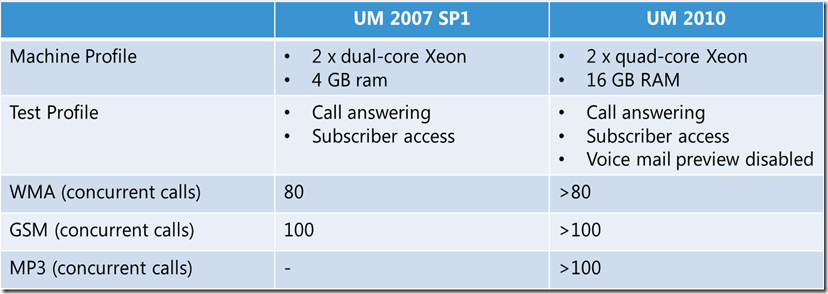Exchange 2010 Unified Messaging
Scalability. Lots of changes with Exchange 2010 including Voicemail preview. We haven’t seen the upper bounds of scale with Exchange 2010 but I can tell you that based on testing with Exchange 2007 SP1 against Exchange 2010 (with Voicemail Preview turned off) we can easily surpass the call concurrency established with Exchange 2007 SP1. Call handling for voicemail will vary based on the codec used and with WMA and a hardware profile with 2xdual-core Xeon/4GB Ram we were able to do 80 concurrent Voicemail calls. With GSM against the same we could do 100. In Exchange 2010 with a 2xquad core Xeon/16GB Ram we can do >80 on WMA, >100 on GSM, and with a new codec >100 on MP3. This translates to approximately 10K users supported via one UM Server.
Caller ID Resolution. One of the other areas that has changed with Exchange 2010 Unified messaging is around Caller ID Resolution. Bottom-line people want to see names not numbers on resolution. Let’s use AD as a source for phone #s in your organization. They probably have a phone number (if populated?) even if they aren’t UM enabled.
In Exchange 2007 Caller ID was based on the following:
- Resolve extension against callee’s dial plan
- Resolve SIP address against SIP proxy address
- Resolve against callee’s personal contacts
- Resolve E164 number against MsRtcSip-Line
In Exchange 2010 we’ve added AD lookup heuristics on several attributes. In AD phone attributes are not indexed and aren’t suitable for a direct query by Exchange UM. Instead UM copies reversed phone numbers to DTMF map attribute which allows a suffix search. Numbers searched (if present):
- telephoneNumber, otherTelephone
- homePhone, otherHomePhone
- mobile, otherMobile
- facsimileTelephoneNumber, otherFacsimileTelephoneNumber
This is controlled by a new property in the UM Dial plan called AllowHeuristicADCallingLineIDResolution (true/false)
Exchange 2010 also can resolve against multiple dial plans. If User 1 (Dialplan A) calls Users 2 (Dial Plan B) and they are on the same PBX the extension lookup performed in the callee’s dial plan and any other dial plans specified by B’s EquivalentDialPlanPhoneContexts. BTW – in Exchange 2007 it would only look in the callee’s B plan.
If we look at the big picture here’s how Caller ID Resolution works in Exchange 2010. More info can be found in our technet guidance here: https://technet.microsoft.com/en-us/library/dd351203.aspx. Paul Robichaux thanks for pointing this out!!!!

_thumb.gif)